Agnes "Eudora" Moorehead stars in this Lady's Gothic, with a passing support role from Vincent Price. Agnes plays a mystery writer who moves onto a country estate with her homely secretary &/or girlfriend (Lenita Lane), where a murderer called "the bat" had formerly killed some people, & never been caught. It seems The Bat (1959) has returned, terrorizing Agnes & her homely pal.
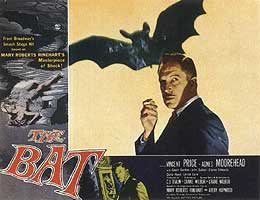 Now I'm very fond of Moorehead as a character actor though she cannot save this turkey. The cast seems to be all radio drama actors of the '40s & '50s, in their forties & fifties, since on radio no one had to be physically appealing. Now I'm very fond of Moorehead as a character actor though she cannot save this turkey. The cast seems to be all radio drama actors of the '40s & '50s, in their forties & fifties, since on radio no one had to be physically appealing.
Homely people threatening homely people could be a great basis for a Z picture, but this was a snoozer in its day & has not increased in interest with vintage bouquet.
The killer likes to turn rabid bats loose as one of his weapons of terror, & since Dr. Wells (Price) is a bat expert, for a while he serves as one of several suspects. But he's not the star as the posters & DVD boxes alleged, so arrives in the story late & leaves early.
When we see The Bat at work (or play), one of his gloves has claw extensions, & he wears a black stocking mask to hide his identity. The big "reveal" at the end is who The Bat really is, though it's not at all interesting when it's known.
Agnes finds a secret room with a safe in it, & the contents of the safe would seem to be what The Bat is really after. A trail of corpses helps his purpose how? And wouldn't setting fire to the coachhouse to trick everyone into leaving actually attract even more people including the entire fire department?
There's never a moment any of this makes sense & there's no pay-off anywhere in the tale. It straddles some shadowy genre region between film noir & horror thriller but achieves none of the impact of either.
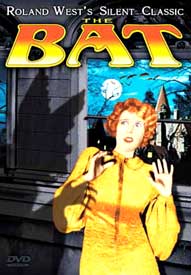 The Agnes Moorhead film was a remake of the silent film of the same title The Bat (1926), itself based on a farcical 1917 play by Mary Roberts Rinehart & Avery Hopwood, the play having been based on Rinehart's bestseller The Circular Staircase (1907). For years this silent film was presumed forever lost, until a single copy in excellent condition resurfaced.
The Agnes Moorhead film was a remake of the silent film of the same title The Bat (1926), itself based on a farcical 1917 play by Mary Roberts Rinehart & Avery Hopwood, the play having been based on Rinehart's bestseller The Circular Staircase (1907). For years this silent film was presumed forever lost, until a single copy in excellent condition resurfaced.
Cornelia (Emily Fitzroy) with her niece Dale (Jewel Carmen, director Roland West's wife) have rented a mansion that seems to be haunted, with the most comic relief provided by their maid Lizzie (Louise Fazenda).
The story is very streamlined, so that it is easily told pictorially & just a few title cards. Its influence on the Old Dark House motif in cinema cannot be overstated, whether for good or bad.
It may also be an unacknowledged but primary influence on the gothic look of Bob Kane's original Batman comics, & even the familiar Bat Signal is present in this film!
The Bat has some amazing set designs inspired by German Expressionism, a villainous burglar who dresses in a weird bat-eared costume, a creepy skeletal butler, so that it is often visually winning, despite a story that was hoary even in 1926. The pressing query "who is The Bat?" isn't much to rely on for suspense. The story embodies a good dose of farcical comedy which is more effective than the elleged suspense
With hidden room, murder, jewel theft, fake hauntings with some moody bits, the not entirely rational garage conflagration, the harping on the issue of a secret identity, & an actual bat, it should've been fully engaging. But the pacing is painfully slow, rendering it mainly interesting as an historically consequential relic.
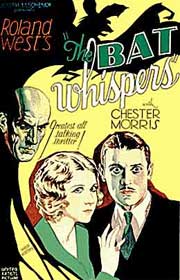 At the arrival of the talkie era, The Bat's director Roland West remade his silent thriller as The Bat Whispers (1930), building on the unusual set design of the original to increase the weird perspectives & angles, crane shots through beautiful miniature work that turns into full-sized sets with surprisingly smooth editing, exaggerating the German Expressionism he'd already imitated in his silent version.
At the arrival of the talkie era, The Bat's director Roland West remade his silent thriller as The Bat Whispers (1930), building on the unusual set design of the original to increase the weird perspectives & angles, crane shots through beautiful miniature work that turns into full-sized sets with surprisingly smooth editing, exaggerating the German Expressionism he'd already imitated in his silent version.
The film was innovatively shot in pre-cinemascope "wide screen," as only a few films at the time were. The difficulty of showing such films on the technology of the time put the kibosh on widescreen for a few years, & only in our modern era have its full letterboxed proportions been restored.
Strangely enough, late in 1930 the Hays Office banned widescreen films because of exhibitors complaining they would be put out of business since their theaters & projectors would have to be completely replaced.
It was originally shot with two camera crews, one for the 65 mm widescreen, another for the regular square-proportioned 35 mm version. Only the latter has been well known. If there may be accounted some degree of genius to the film, it is not in acting, or story, or anything other than the design work, & the square version is deprived of the full impressive visual effect of the 65 mm version.
If a viewer had only time or inclination for one of these three films, it really must be the restored widescreen film from 1930.
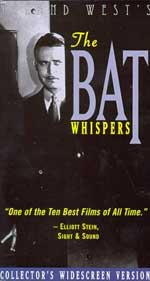 The two versions have many variant moments between them, since they had different crews working in overlapping shifts, resulting in many subtle & a few major differences in pacing, set-up, & performance. The widescreen version is available restored by the UCLA Film & Television Archive, with the 35 mm version on the same disc for comparison. The two versions have many variant moments between them, since they had different crews working in overlapping shifts, resulting in many subtle & a few major differences in pacing, set-up, & performance. The widescreen version is available restored by the UCLA Film & Television Archive, with the 35 mm version on the same disc for comparison.
I only sampled the square version, so I'm really only reviewing the visually exciting widescreen film, & it so impresses the eye that one could easily mistake it for a masterpiece if the hoariness of the underdeveloped melodrama were not in the equation. If I hadn't already seen this too-simple-a-story in two other versions, I might've been more captivated by the tale, but as it is I found only the visuals praiseworthy.
With minor differences the story is the same as in the silent film, but with plenty of dialogue added. The Bat announces his daring burglaries beforehand, yet the police cannot stop him.
A wealthy matron Cornelia (Grayce Hampton) & her servant Lizzie (Maude Eburne) have a summer rental. The Bat is after his next prize in a secret hidden room of their house & so tries to frighten them out of the house so he can search the place at leisure.
Cornelia is a tough old bird who refuses to be frightened out of the residence, while her comic sidekick Lizzie runs about being scared half to death, though smart enough to set an effective trap. As they investigate the seeming haunting, many side-characters come & go through the old dark house on a stormy night, & everyone seems to have their own mysterious agenda.
It culminates in the trivial revelation of who The Bat really is. Apart from getting to behave like more of a maniac than in the other versions, it's simply not much of a climax. As the credits start rolling, suddenly the audience is instructed not to leave yet, & Chester Morris appears as if by magic center stage to give a campy speech begging the audience never to reveal the ending or The Bat may get them next. This coda is more winning than the film's actual climax.
copyright © by Paghat the Ratgirl
|
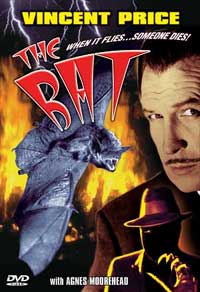
 Now I'm very fond of Moorehead as a character actor though she cannot save this turkey. The cast seems to be all radio drama actors of the '40s & '50s, in their forties & fifties, since on radio no one had to be physically appealing.
Now I'm very fond of Moorehead as a character actor though she cannot save this turkey. The cast seems to be all radio drama actors of the '40s & '50s, in their forties & fifties, since on radio no one had to be physically appealing.

 The two versions have many variant moments between them, since they had different crews working in overlapping shifts, resulting in many subtle & a few major differences in pacing, set-up, & performance. The widescreen version is available restored by the UCLA Film & Television Archive, with the 35 mm version on the same disc for comparison.
The two versions have many variant moments between them, since they had different crews working in overlapping shifts, resulting in many subtle & a few major differences in pacing, set-up, & performance. The widescreen version is available restored by the UCLA Film & Television Archive, with the 35 mm version on the same disc for comparison.